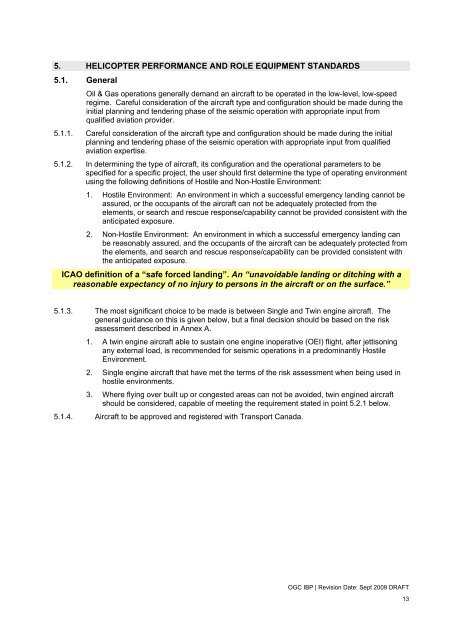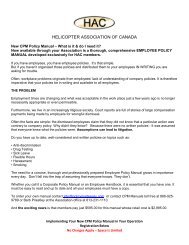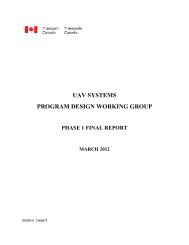HAC Oil & Gas IBP - Helicopter Association of Canada
HAC Oil & Gas IBP - Helicopter Association of Canada
HAC Oil & Gas IBP - Helicopter Association of Canada
Create successful ePaper yourself
Turn your PDF publications into a flip-book with our unique Google optimized e-Paper software.
5. HELICOPTER PERFORMANCE AND ROLE EQUIPMENT STANDARDS5.1. General<strong>Oil</strong> & <strong>Gas</strong> operations generally demand an aircraft to be operated in the low-level, low-speedregime. Careful consideration <strong>of</strong> the aircraft type and configuration should be made during theinitial planning and tendering phase <strong>of</strong> the seismic operation with appropriate input fromqualified aviation provider.5.1.1. Careful consideration <strong>of</strong> the aircraft type and configuration should be made during the initialplanning and tendering phase <strong>of</strong> the seismic operation with appropriate input from qualifiedaviation expertise.5.1.2. In determining the type <strong>of</strong> aircraft, its configuration and the operational parameters to bespecified for a specific project, the user should first determine the type <strong>of</strong> operating environmentusing the following definitions <strong>of</strong> Hostile and Non-Hostile Environment:1. Hostile Environment: An environment in which a successful emergency landing cannot beassured, or the occupants <strong>of</strong> the aircraft can not be adequately protected from theelements, or search and rescue response/capability cannot be provided consistent with theanticipated exposure.2. Non-Hostile Environment: An environment in which a successful emergency landing canbe reasonably assured, and the occupants <strong>of</strong> the aircraft can be adequately protected fromthe elements, and search and rescue response/capability can be provided consistent withthe anticipated exposure.ICAO definition <strong>of</strong> a “safe forced landing”. An “unavoidable landing or ditching with areasonable expectancy <strong>of</strong> no injury to persons in the aircraft or on the surface.”5.1.3. The most significant choice to be made is between Single and Twin engine aircraft. Thegeneral guidance on this is given below, but a final decision should be based on the riskassessment described in Annex A.1. A twin engine aircraft able to sustain one engine inoperative (OEI) flight, after jettisoningany external load, is recommended for seismic operations in a predominantly HostileEnvironment.2. Single engine aircraft that have met the terms <strong>of</strong> the risk assessment when being used inhostile environments.3. Where flying over built up or congested areas can not be avoided, twin engined aircraftshould be considered, capable <strong>of</strong> meeting the requirement stated in point 5.2.1 below.5.1.4. Aircraft to be approved and registered with Transport <strong>Canada</strong>.OGC <strong>IBP</strong> | Revision Date: Sept 2009 DRAFT13









